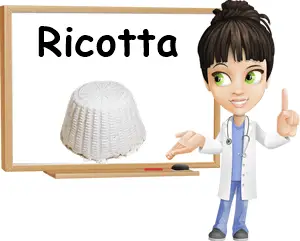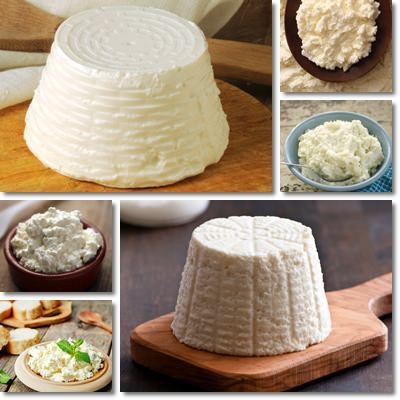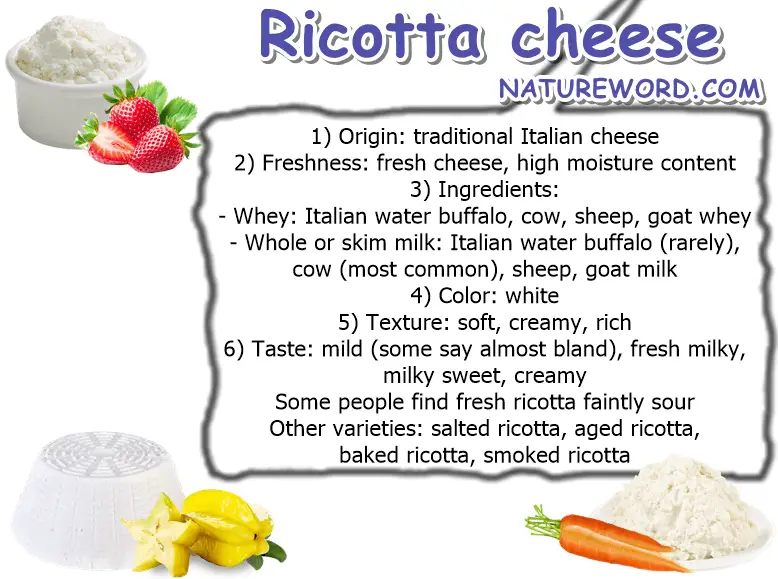What is ricotta? Ricotta is a soft, fresh Italian cheese made from whey, the liquid left over after making cheese from milk. It is a young, unripened, white cheese with a sweet taste and high moisture content, but a short shelf life. Originally, ricotta was made from whey from cow’s milk or Italian water buffalo milk, sometimes with the addition of whole milk as well. Nowadays, it’s less frequently made from Italian water buffalo whey outside of its homeland and more commonly from whey from cow, goat and sheep milk which is more cost-effective. The variety made from whey from sheep milk (Ricotta romana) has become a protected variety under the EU’s Protected Designation of Origin (PDO) legislation. There are also varieties made from whole milk or skim milk as well as salted, baked, aged and smoked ricotta.
What does ricotta mean?
The word ‘ricotta’ means ‘recooked’ in Italian and has to do with the fact that it is a whey cheese, whey being a by-product of cheese making. To make cheese, milk is heated or cooked to a certain extent.
The leftover liquid, the whey, is also heated almost to boiling point, so technically also cooked to a certain extent in order to make whey cheeses such as ricotta.
As such, it can be considered that ricotta is a recooked cheese since the whey undergoes two heating/cooking processes, once in the form of whole milk to make cheese and a second time as whey to make whey cheese.
Because whey is a residual liquid from processing milk for cheese-making, ricotta is sometimes not considered a real cheese, but more of a dairy product similar to cheese.

What is ricotta cheese like?
Here are the most notable characteristics of the cheese:
1) Raw material: Whey from Italian water buffalo or cow’s milk (original). Currently also whey from goat and sheep’s milk and whole milk for a creamier consistency.
2) Freshness. Ricotta is a fresh cheese (unripened, not aged). What this means is that it’s meant to be eaten as soon as possible after being produced and refrigerated until it is consumed. As a fresh cheese, it’s also light in color, with a mild taste and has no rind.
3) High moisture content. Because it is a fresh cheese, ricotta has a high moisture content. Of course, there are ripened varieties available which are left to age for up to a year, allowing for a reduced moisture content, firmer consistency, stronger taste with unique flavor notes and longer shelf life.
4) Short shelf life. The original ricotta has a short shelf life of about 1 week in refrigerator conditions, but is best consumed as fresh as possible.
5) Consistency. Ricotta is a solid, but soft, creamy cheese. It’s crumbly (because it’s fresh and not set like aged cheeses), but not grainy. It can be molded to take the shape of the vessel or container it’s being kept in or lack a definite shape, similar to some cottage cheeses.
What does ricotta cheese look like?
Ricotta is a soft, but solid type of cheese. It’s a fresh cheese variety with a milky white color and soft, creamy, sometimes slightly crumbly texture (but not grainy). Because it’s a fresh cheese, meaning it’s not aged, it doesn’t have a rind like parmesan, for example. Also see Properties and Benefits of Parmesan Cheese.
What does ricotta cheese taste like?
Original ricotta is a fresh, mild tasting cheese with sweet milky flavors. Some people find it almost bland, while others report faint sour notes. There is also a salted variety. Aged varieties taste different, depending on how they’ve been processed (salted, smoked etc.).
See also :Can You Freeze Ricotta Cheese?
The 5 most common types of ricotta
1) Fresh ricotta. The original variety, high-moisture, soft, sweet, creamy and mild tasting.
2) Ricotta salata. Solid, pressed ricotta available in wheel forms. White, off white color. It’s salted and left to dry (age) to reduce its moisture content, increase shelf life and flavor.
3) Ricotta affumicata. Or smoked ricotta: solid piece of cheese with a firm consistency, creamy, even slightly buttery texture, low moisture content and long shelf life. Has a brownish crust and aromatic, woody, herbal flavors.
4) Ricotta infornata, al forno. Is essentially fresh ricotta that has been baked to reduce moisture content and increase flavor. May be baked slightly, only until it forms a yellowish-brown crust but remains white on the inside, or until it becomes brown or grayish-black on the outside and a pale shade of brown on the inside.
5) Ricotta forte. Aged, fermented ricotta variety with a strong, sharp taste and piquant flavor notes from the accumulation of various acids (lactic acid, acetic acid, butyric acid etc.). Creamy texture, spreadable consistency, light cream color. Not for the faint of heart.

What does ricotta cheese go with?
Personally, I eat fresh ricotta cheese with Nutella as a dessert or midday snack. Two different types of creamy and soft that complement each other perfectly. It’s honestly my favorite, no-bake, go-to dessert.
Ricotta and spinach is a classic Italian combination: you can make a baked ricotta and spinach stuffed shells or penne pasta or ricotta and spinach ravioli or cannelloni that will impress literally everybody.
Ricotta and spinach is a great twist of the traditional lasagna. Pair with bananas for a simple, easy and nutritious dessert, although any fruit you like will do. Or you can just eat ricotta cheese raw and enjoy the soft, creamy, delicate cheese and get some great nutrition.
Ricotta nutrition. There is significant difference between the original variety made from whey and the new varieties made from whole milk in terms of nutritional value. Given that the focus of this article is the original Italian cheese, the following nutritional information applies for ricotta made from sweet whey.
Ricotta nutritional information
1) Good energetic value. One of the benefits of ricotta cheese is that it’s moderately low in calories. 100 g of the fresh cheese provides around 140 kcal. So if you’re looking to lose weight, you could introduce ricotta into your diet or substitute unhealthier options with it. To compare, ricotta made from skim and whole milk provides anywhere from 160 to 240 kcal per 100 g.
2) High in protein. Although whey is less than 1% protein, you need quite a lot of it to make ricotta, so the protein builds up in the final cheese. 100 g of fresh ricotta cheese may provide anywhere from 7 to 12 g of protein. This is in accordance with research that shows dry whey solids are approximately 10% protein. Protein is essential for both mental and physical health and although ricotta protein content differs between brands, it is still a generous source.
Learn more about the Properties and Benefits of Whey Protein.
3) Important source of fat. Although whey (the raw material for the production of the fresh Italian cheese) is less than 1% fat, given that it takes a lot of whey to make ricotta, fat does add up in the end. How much fat is in ricotta cheese varies from brand to brand. The high-moisture whey ricotta is around 8-10% fat, compared to whole milk ricotta which is between 20 and 40% fat. On average, 100 g of fresh ricotta cheese supplies 8 to 10 g of fat.
4) Moderately low source of lactose. Whey may contain anywhere between 40 and almost 80% lactose, but ricotta is only between 1 and 5% lactose. For those that are not severely lactose intolerant, it’s actually a good cheese to eat in moderate amounts. But if you’re seriously lactose intolerant, avoid it altogether.
5) Good source of vitamins and minerals. Overall, the cheese variety provides good amounts of vitamins B2 and B12, calcium, potassium, phosphorus and sodium. Smaller amounts of other essential nutrients may be present as well, including other B vitamins and vitamin A. Ricotta is extremely low in vitamin K, vitamin B9 (folate), vitamin D and has no vitamin C.

It’s important to understand that only the cheese varieties from big brands have a standardized nutritional profile; the nutritional profile of ricotta from small producers and artisan cheese-makers can only be estimated as no two batches of cheese will be exactly alike.
See more cheese varieties and other dairy products and learn about their nutritional properties, benefits and side effects on our Dairy Page.
How is ricotta cheese good for you?
Some of the most noteworthy benefits of the cheese are:
1) Provides nourishment for the brain thanks to its good protein and fat content.
2) Good for building muscle thanks to its protein content.
3) Satiating and energizing as a result of nutritional profile (micro and macronutrients).
4) Benefits weight loss, when consumed in limited amounts as part of a balanced and varied diet.
5) Easy on the stomach, unless you have severe lactose intolerance or gastritis. It’s lighter than other cheeses.
6) Helps with brain fog, boosts productivity, supports learning and memory.
7) Source of antioxidants with large scale benefits.
8) Good for strengthening bones and teeth.
9) Helps with the absorption of fat soluble vitamins A, D, E and K.
